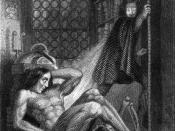Mary Shelley's "Frankenstein" develops the theme of alienation and isolation which in result shows the reader in detail the society's assumptions and moral values. Throughout the elaborate novel the creature Victor Frankenstein created is the main focus of alienation. Some writer's say that this theme of alienation originate from a variety of elements, such as Mary Shelley's father, William Godwin, who believed that if one is to be isolated they will turn violent. This theme is particularly important because it really shows us the moral beliefs and values of society. Throughout the novel there are three main events that portray society's beliefs, which include, the creature being attacked by villagers, Felix's violently aggression towards the creature, and the man who shot the creature.
After escaping from Victor's apartment the creature roams in the woods. The creature finds a village and decided to investigate a little more. The creature knows that it might be risky going into the village but, he is tempted by hunger.
Right when the benign and unschooled creature put in his foot in the first little hut the villagers screamed and ran away. This was followed brutal attacks by some of the villagers. Stones and other projectiles were thrown at the creature and he was badly bruised. "The whole village was roused; some fled, some attacked me, until, grievously bruised by stones and many other kinds of missile weapons." This quote shows us that society judged the poor creature, based on the way he looked, "yellow skin...watery eyes...straight black lips." The first reaction by the villagers was to run from a ugly looking monster. No one in the village, not one person tried to speak or communicate with the creature, even though the creature did not signify any body language that portrayed aggression. They did...


